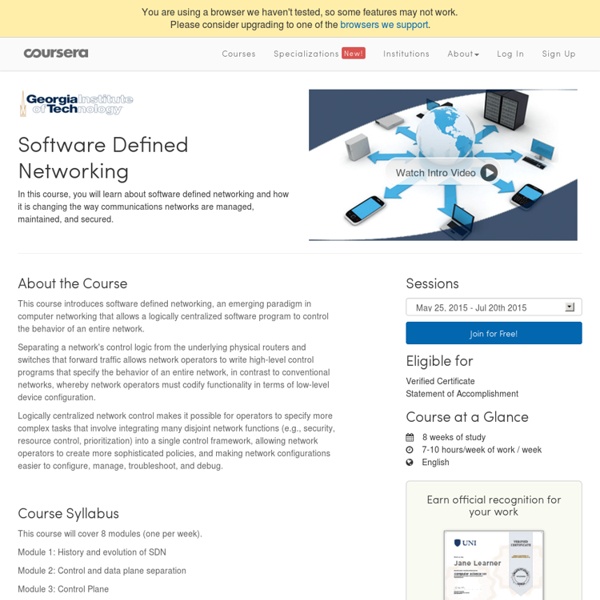Software Defined Networking course GA Tech

Useful mininet setups | SDN Hub
Mininet is a network emulation platform that is very useful to test SDN applications that you build. It can support different types of topologies. Here we showcase three popular configurations that will be helpful for testing. 1. Following command spawns a single switch with 3 hosts attached to it. $ sudo mn --arp --topo single,3 --mac --switch ovsk --controller remote In the above command, there are some important keywords worth paying attention to: –mac: Auto set MAC addresses–arp: Populate static ARP entries of each host in each other–switch: ovsk refers to kernel mode OVS–controller: remote controller can take IP address and port number as options You can now perform ping between hosts h1 and h2 using command h1 ping h2. 2. Following command spawns two switches connected to each other with a link and has one host on each switch. $ sudo mn --topo linear --switch ovsk --controller remote 3. Following command spawns a switch that has 3 servers and 1 client connected to it.
SDN Test Suite – Methodology | SDN Hub
SDN Test Suite – Methodology Typical SDN-based Network Virtualization The architecture rolled out can be one of the following: Pure-overlay: Programmable virtual dataplane elements (vDP) are inserted into edge servers and controlled by the controller cluster. They form overlay networks using tunnels that are routed over the legacy network fabric. Pure-underlay: SDN-enabled top-of-rack or leaf physical switches are deployed and controlled by the controller cluster. Testing these solutions irrespective of the architectural choice makes it essential to adopt a black-box testing methodology that integrates leverages components from the computing world and the networking world. Classes of Tests For testing Network Virtualization, we divided our tests into four main categories: Functionality tests: Essentially these test the claimed (and unclaimed) features of the network-virtualization solution, including the following. Setup for functionality and data plane tests using bare-metal servers
Spanning Tree and OpenFlow
Questions I often get asked include: Can you run Spanning Tree and OpenFlow together?What happens when Spanning Tree blocks a port? What will OpenFlow do? Firstly, it is possible to run an OpenFlow network connected to the HP VAN SDN Controller with Spanning Tree turned off. In this blog entry I will show you a simple network with a look and demonstrate what happens with Spanning Tree turned off as well as on using HP Comware switches. VLAN 1 = Management VLAN (Used for communication with the Controller. In this topology I am using two 5900AF-48G-4XG-2QSFP+ switches with the following details: [5900-1]dis version HP Comware Software, Version 7.1.045, Release 2307 Copyright (c) 2010-2013 Hewlett-Packard Development Company, L.P. [5900-2]dis version HP Comware Software, Version 7.1.045, Release 2307 Copyright (c) 2010-2013 Hewlett-Packard Development Company, L.P. In the output below, you can see that Spanning Tree is disabled on VLAN 10: VLAN 192 is the link to the HP VAN SDN Controller:
Related:
Related:



